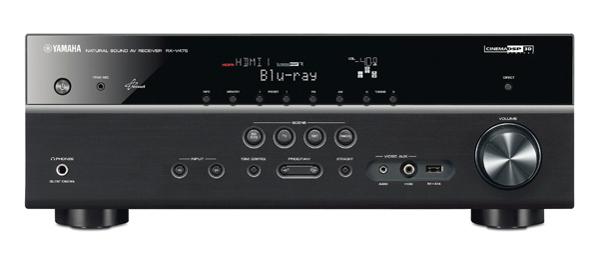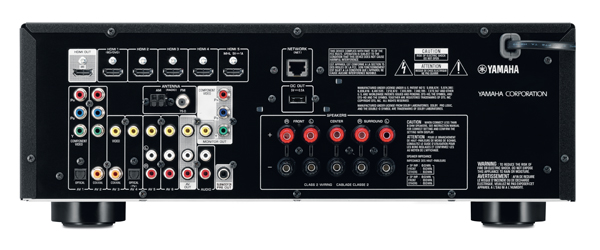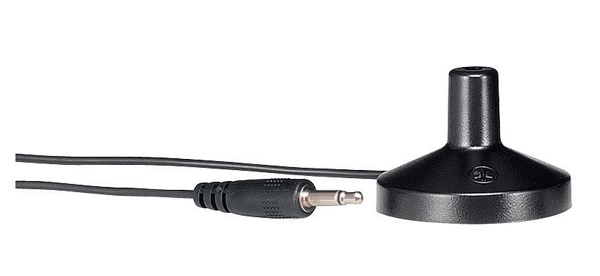Yamaha RX-V475 A/V Receiver

Price: $450 At A Glance: Great sound for the price • MHL-enabled HDMI • Tricky setup
In a world so mixed up, muddled up, and shook up that we can’t even depend on Superman to wear his red Underoos outside his pants like a proper superhero, it’s heartening to know that tax evasion and mortality aren’t the only certainties in life anymore. If anything, a new slate of A/V receivers from the big names in consumer electronics is even a surer certainty, with high-end features from last year’s offerings trickling down a model number or two and support for the latest connectivity features from the middle of the line on up.
In a lineup consisting of five RX-V models (a quite modest number compared with much of Yamaha’s competition in the AVR market), with prices running the gamut from $300 to $850 MSRP, the $450 RX-V475 is actually one notch below the middle, and yet still receives the fonction de l'année: an MHL (Mobile High-Definition Link)-enabled HDMI input. Being the iPhone devotee I am, that isn’t an essential upgrade for me, although it does make the RX-V475 compatible with the Roku Stick. That’s handy, because otherwise, there aren’t a lot of features to discuss—new or otherwise.
Thankfully, though, in terms of pure audio quality alone, the RX-V475 still remains a strong contender amongst sub-$500 5.1-channel A/V receivers.
Features
A quick look at the back of the RX-V475 reveals just how little has changed since last year’s RX-V473. Aside from the addition of a USB port designed to power Yamaha’s optional Wi-Fi and Bluetooth adapters, the aforementioned additional HDMI input with MHL capabilities (bringing the grand total of HDMI inputs up to five), and a weensy shuffling of text as a result, everything is identical. Around front, even less has changed from last year’s equivalent model; the front USB port—which unlike its back-panel counterpart can be used for iOS device connectivity (and charging, but only when the receiver is powered on)—is no longer actually labeled “USB,” the assumption being, I guess, that you’re not going to mistake it for FireWire or something.
All of last year’s features on the RX-V473 have carried over, so you’ll get AirPlay connectivity, though by default the RX-V475’s sub-0.1-watt standby power consumption keeps you from using AirPlay to power on the receiver automatically. Dig deep into the receiver’s setup menus, though, turn on the Network Standby feature, and you’ll have access to power-on capabilities via both AirPlay and Yamaha’s AV Controller App.

The AV Controller App hasn’t improved in form or function since last year and still offers only the basics in terms of control, except when it comes to the RX-V475’s one noteworthy additional feature: Pandora. Unless you’re using the AV Controller App, Pandora is a bit tricky to find, though; you won’t find any mention of it in the instruction manual. Here’s the big secret: you have to repeatedly tap the Net button toward the top of the cramped, cluttered remote to gain access to this service—not the NET Scene button that more naturally catches your eye.
The AV Controller App is also useful if you want to stream audio directly from a USB-connected smartphone or tablet, since you can’t actually access your libraries directly through your phone’s Music app and expect to hear anything.
In the RX-V475, Yamaha’s Scene buttons make a return, allowing you to set-and-forget the sound decoding or DSP function you want associated with a particular input and instantly fire up the receiver, select that input, and dial in those settings. Although, again, with two of the four Scene buttons set by default for use with Internet and terrestrial radio, and the other two specifically for TV and BD/DVD, the functionality is rather limited unless you are willing to customize them.
Setup
As expected, the user interface for the RX-V475 also remains virtually unchanged from last year’s models, although interestingly enough, I did run into some issues with the Yamaha Parametric Room Acoustic Optimizer (YPAO) that have never plagued me before. I connected the system to the exact same speakers I used to review the RX-V473, with the same subwoofer, in the same physical settings and yet, upon running YPAO, I was greeted with a “W-3: Level Error” code. The user manual pointed toward the subwoofer as the most likely culprit, so I turned it down, ran YPAO again, met with the same error, and promptly ignored it. That turned out to be a big mistake, since bass was positively overwhelming as a result.

In the end, dialing the subwoofer’s volume knob to near-zero and running YPAO again resolved that error and balanced the bass fairly well, but with some quirks. The distance it selected for my sub would place it somewhere in the suburbs of Peoria (and for the record, I live in Alabama), and just like last year, YPAO decided on an 80-hertz crossover point for the sub/sats, which is entirely too low for the highly compact Polk Audio Blackstone TL3 satellites I have in my secondary listening room.
Still, though, I have to say: For all the frustrations in the setup process, once I had the crossover set manually and made YPAO happy with a sufficiently subdued subwoofer, the resulting room correction was again quite good. Much better than I’ve experienced with Audyssey’s basic MultEQ, which used to be the room correction system of choice for $500-ish receivers, until Denon recently stepped up the game by adding MultEQ XT to its $499 IN-Command AVR-X1000 receiver.
Speaking of Denon, the beautifully spread-out and vertical binding posts of that company’s new offerings also shine a harsh light on the fact that Yamaha’s speaker connections remain cramped, so unless your speaker cables are terminated with banana plugs (mine are), connections might be a little frustrating.































































